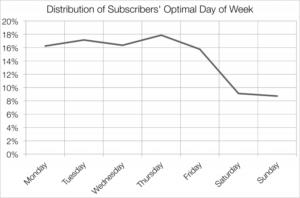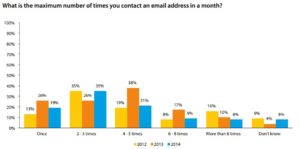While every marketer has their own preferred method, there’s one thing we can all agree on: there are no shortage of ways to communicate with a desired audience. One of the simplest, fastest (and arguably most effective!) ways to distribute content to current and future clients is through the use of email marketing.
Before we dive into best practices, let’s check some stats:
- 92% of online adults use email, with 61% using it on an average day. (PEW)
- 91 percent of US adults like to receive promotional emails from companies they do business with (MarketingSherpa)
- Email has an average ROI of $38 for each $1 spent (DMA)
- A message is 5x more likely to be seen in email than via Facebook. (Radicati)
Okay, now that you know what a game-changer email marketing can be for your business, let’s make sure you’re doing it right. So what are the best practices for email marketing?
When to Send
While there is no magical time of day to hit send, there are general rules you can follow for successful email marketing.
A recent study from MailChimp suggests that (generally), the best time of day to communicate with your subscribers is on a weekday in the mid-morning, between 10am and 12pm. However, this can vary if your business is hobby, arts, or retail-related. In those cases, the optimal time to send your emails is on the weekend.

Beyond that, the truth is that the right time to send your marketing emails will depend on your industry. That’s why it’s key to do your research and know your audience. Consider the factors that would influence how and when people might engage with your emails. Are they in a particular timezone? Do they work a typical 9-5 schedule, or are their hours more varied? Are they a stay-at-home parent, or a working professional? How old are they? All of these indicators are critical to knowing what the optimal time of communication might be, and success will depend on how well you know your clients.
How Much is Too Much?
Once you have a clear understanding of the right time to be sending your messages, the next place to focus is your frequency. The last thing you want to do is miss out on business opportunities by sending too infrequently – or lose subscribers because you sent too often.
When someone signs up to receive email messages from you, a great best practice is to send a follow-up email. This should explain what kind of communication they can expect to receive from your business, and then stick to it. Set consistent expectations for your messaging and frequency, and provide your readers with valuable information to keep them engaged.
In a survey from The Direct Marketing Association, we can see that the average maximum emails sent per month is 2-3. This is a great place to start, but as with the right time to send, the right frequency will depend on your business and your audience.

Don’t Forget Your Readers
It’s all too easy to fall into the trap of focusing on clicks, conversion, ROI, and leads. While those things are important, it’s equally as important to remember that our “current and prospective clients” are more than that: they’re humans, too. So we should talk to them like they’re humans! When we meet people in person, we strive to establish a connection and build a relationship, and our email marketing shouldn’t be any different.
Personalized email messages improve click-through rates by an average of 14% and conversions by 10% (Aberdeen). By sending out informed, relevant, and specifically-crafted content that is written and timed for your audience, you can broaden your reach and inspire brand loyalty.
Are you interested in email marketing but missing critical insights on your prospective audience? Do you need support crafting unique and branded content for your email campaign? Connect with the Email Marketing specialists at mConnexions, and let us put our skills to work for your business.
